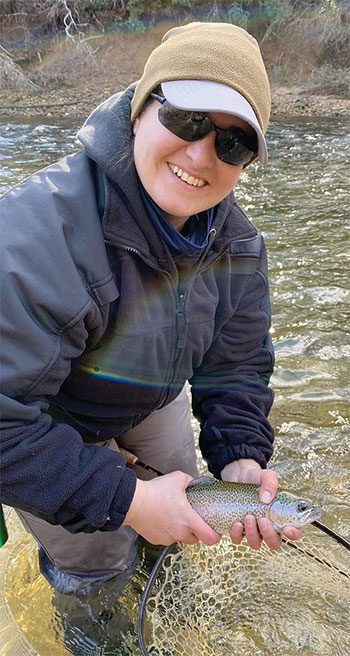Winter fly fishing in the Southeast has been a roller coaster of events this season. Temperatures below freezing a few days, a day or two a week with heavy rains, a few spring-like-feeling days with plenty of warm sun, but no snowfall for South Carolina. For some, the no-snow is a blessing, compared to the havoc nature creates here when it snows; although some of us love the snowfall and the quiet stillness it brings streamside. We’ll have to see if Mother Nature will grace us with a little snow. February brings the same mixed bag of weather, with changing temperatures, and a wide variety of water conditions.
While temperatures hover near the freezing mark for a few nights, water temperatures will be in the low forties. The use of heavy nymph dropper rigs, with small trailer flies, will get flies down in the depths of the river quickly to find fish on the river bottoms. Small, heavy steamers will also produce fish with dead-drift and slower retrievals. Fortunately, the weather does not consistently stay below freezing for very long, and milder days bless the riverside, along with the emergence of some hatching bugs. Although hatches can be sporadic, and trout apprehensive to rise to dry flies, there are some gorgeous short sleeve, dry fly fishing days. A good approach is to have a few dry flies, an array of emergers, numous soft-hackles, along with various nymphs. On warmer days, having a tandem nymph set up for early mornings, then transitioning higher in the water column as the sunlight warms the water to emerger patterns and soft-hackles. Dead-drifting and swinging the emergers and soft-hackles will produce good numbers of fish.
Dry fly days may be limited, but never obsolete. Longer leaders, smooth casts, and long drifts will make a productive mid-day to afternoon. Be patient, do not rush, and watch for dimples or rings on the water’s surface, and it will be time to tie on the dry fly. Watch for bugs flying off the water, and a careful capture of one of these mayflies or caddis will be very helpful in choosing options for the fly to tie on. First, whether the bug is a caddis or mayfly; second, the size and shape; and third, the color of the fly. Casting and drifting to rising fish, and a sign of refusals, tie on a smaller size of the same fly. Further refusals from the trout – start swinging the emerger of the bug toward these fish, as they may not be eating the adults on the water’s surface.
February also brings the Atlanta Fly Fishing Show, and this brings a great time to see new products we will be carrying in our shop, learning great techniques and information from a great wealth of knowledge in the industry. We hope to see everyone out on the rivers, and let’s all of us remember to “leave no trace”, as we enjoy our time on the river.
Karl and Karen Ekberg are co-owners of Chattooga River Fly Shop, located at 6832-A Highlands Hwy, Mountain Rest, SC 29664. Give them a call at (864) 638-2806 and visit their website at www.chattoogariverflyshop.com.
